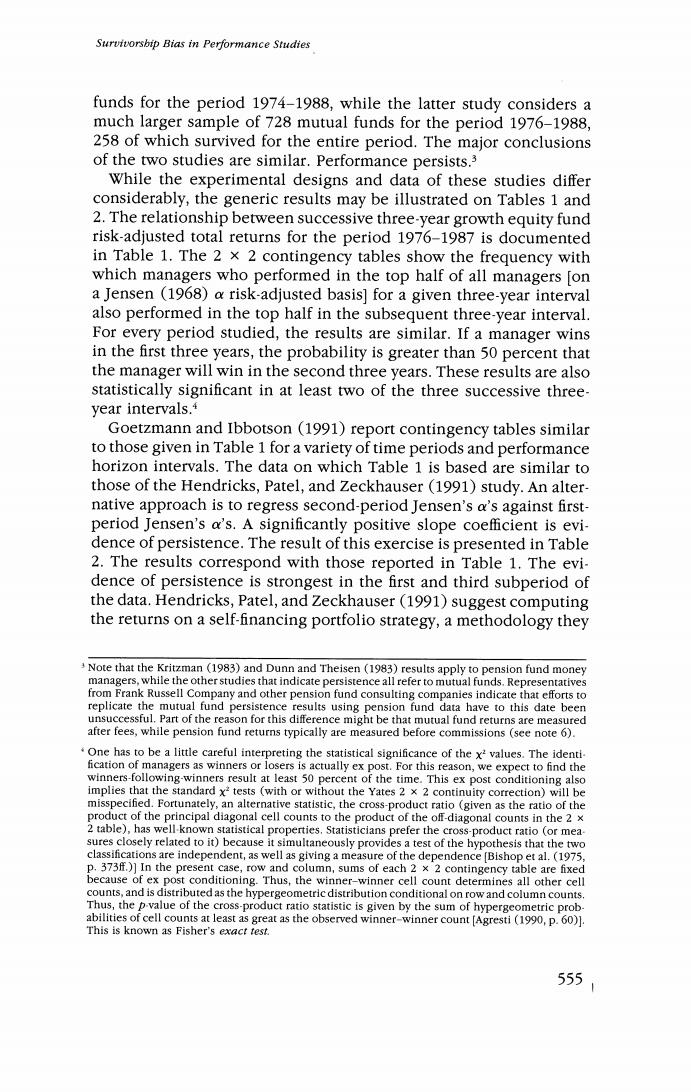正在加载图片...

Survivorship Bias in Performance Studies funds for the period 1974-1988,while the latter study considers a much larger sample of 728 mutual funds for the period 1976-1988, 258 of which survived for the entire period.The major conclusions of the two studies are similar.Performance persists.3 While the experimental designs and data of these studies differ considerably,the generic results may be illustrated on Tables 1 and 2.The relationship between successive three-year growth equity fund risk-adjusted total returns for the period 1976-1987 is documented in Table 1.The 2 x 2 contingency tables show the frequency with which managers who performed in the top half of all managers [on a Jensen (1968)a risk-adjusted basis]for a given three-year interval also performed in the top half in the subsequent three-year interval. For every period studied,the results are similar.If a manager wins in the first three years,the probability is greater than 50 percent that the manager will win in the second three years.These results are also statistically significant in at least two of the three successive three- year intervals. Goetzmann and Ibbotson (1991)report contingency tables similar to those given in Table 1 for a variety of time periods and performance horizon intervals.The data on which Table 1 is based are similar to those of the Hendricks,Patel,and Zeckhauser (1991)study.An alter- native approach is to regress second-period Jensen's a's against first- period Jensen's a's.A significantly positive slope coefficient is evi- dence of persistence.The result of this exercise is presented in Table 2.The results correspond with those reported in Table 1.The evi- dence of persistence is strongest in the first and third subperiod of the data.Hendricks,Patel,and Zeckhauser (1991)suggest computing the returns on a self-financing portfolio strategy,a methodology they Note that the Kritzman (1983)and Dunn and Theisen (1983)results apply to pension fund money managers,while the other studies that indicate persistence all refer to mutual funds.Representatives from Frank Russell Company and other pension fund consulting companies indicate that efforts to replicate the mutual fund persistence results using pension fund data have to this date been unsuccessful.Part of the reason for this difference might be that mutual fund returns are measured after fees,while pension fund returns typically are measured before commissions (see note 6). One has to be a little careful interpreting the statistical significance of the x'values.The identi. fication of managers as winners or losers is actually ex post.For this reason,we expect to find the winners-following-winners result at least 50 percent of the time.This ex post conditioning also implies that the standard x2 tests (with or without the Yates 2 x 2 continuity correction)will be misspecified.Fortunately,an alternative statistic,the cross-product ratio (given as the ratio of the product of the principal diagonal cell counts to the product of the off-diagonal counts in the 2 x 2 table),has well-known statistical properties.Statisticians prefer the cross-product ratio (or mea- sures closely related to it)because it simultaneously provides a test of the hypothesis that the two classifications are independent,as well as giving a measure of the dependence (Bishop et al.(1975 p.373ff.)]In the present case,row and column,sums of each 2 x 2 contingency table are fixed because of ex post conditioning.Thus,the winner-winner cell count determines all other cell counts,and is distributed as the hypergeometric distribution conditional on row and column counts. Thus,the p-value of the cross-product ratio statistic is given by the sum of hypergeometric prob- abilities of cell counts at least as great as the observed winner-winner count [Agresti (1990,p.60)]. This is known as Fisher's exact test. 555